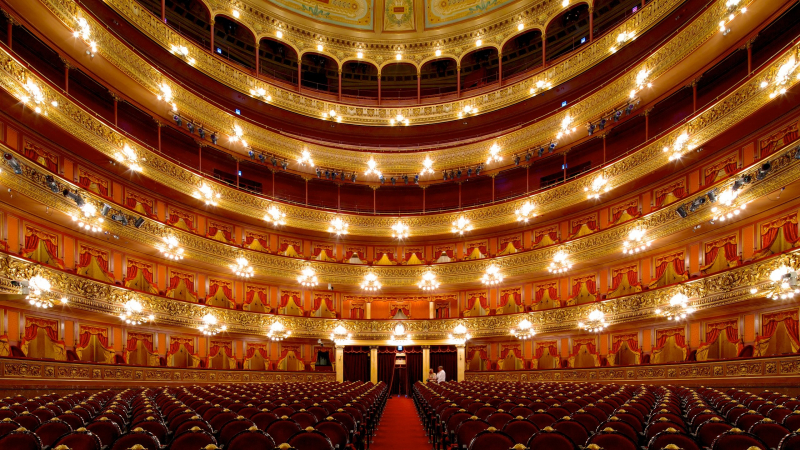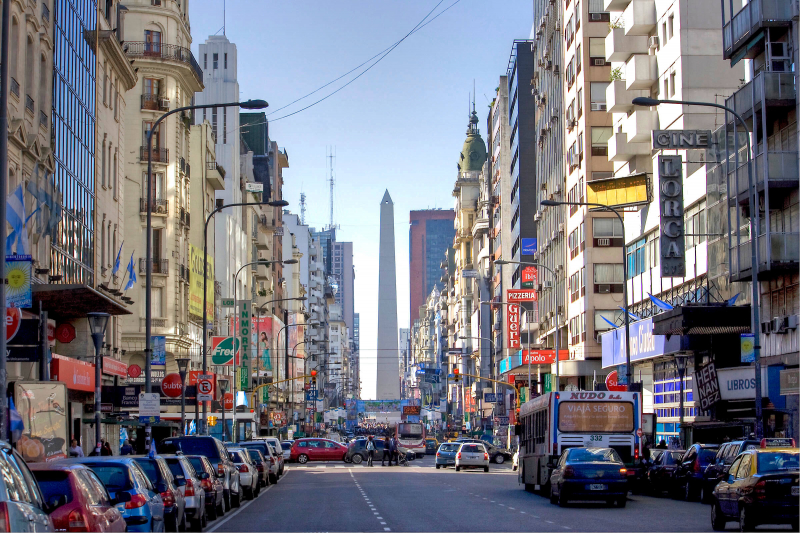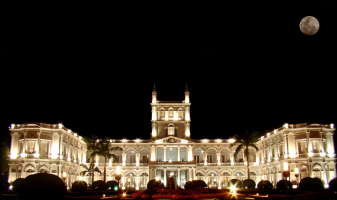Top 10 Places to Visit in Buenos Aires
Color, Tango, and Dance. When someone discusses Buenos Aires, the capital city of Argentina, a lively South American country, these are the first couple of ... read more...words that come to mind. The city has well-preserved Spanish colonial architecture blended in with various European architectural forms and its own unique cultural blend, making it one of Latin America's most visited locations. Toplist has compiled a list of the best places to visit in Buenos Aires for you.
-
The enormous Teatro Colón, one of Buenos Aires' finest landmarks, covers a full city block and an even larger place in the hearts and minds of Argentines. According to National Geographic, the theater is one of the greatest five opera houses in the world for acoustics, ranking third overall behind La Scala in Milan and Teatro di San Carlo in Naples.
The Colón has been known for producing world-class operas, ballets, and classical music acts since it first opened its doors over a century ago. Mara Callas, Astor Piazzola, Richard Strauss, Igor Stravinsky, Plácido Domingo, and Luciano Pavarotti are among those who have performed here. Pavarotti famously stated that the acoustics were so superb that it made him anxious to perform because any error was accentuated.
The majestic seven-story structure contains about 2500 seats and standing room for 500 spectators. It is designed in the style of other twentieth-century European theaters, with a horseshoe form and an attractive dome on the ceiling painted by Argentine Ral Soldi in 1966.
The sparkling chandelier in the center weights a whopping five tons. Every inch of the Colón is adorned with meticulous attention to detail; even the velvety crimson seats are packed with horsetails, and every feature of the theater is designed to provide the best acoustics imaginable.
- Google Rating: 4.8/5
- Opening Hours: Mon to Sat - 9:00 to 20:00, Sun and Holidays - 9:00 to 17:00
- Website: https://teatrocolon.org.ar/
- Address: Cerrito 628, Buenos Aires, Argentina

expedia.com 
experitour.com -
The Metropolitan Cathedral, which faces Plaza de Mayo, is the principal location of the Catholic Church in Argentina, and it is where Pope Francis, as Archbishop Jorge Bergoglio, used to perform mass before taking office in the Vatican in 2013. In commemoration of Bergoglio, the Cathedral currently houses the Pope Francis Museum, which displays some of his personal and liturgical items.
You might be struck by the building's façade, which seems more like a Greek temple than a Catholic church. The twelve Neo-Classical columns at the front depict the twelve apostles of Christ, and they support a triangle frontispiece. This bas-relief frontispiece represents the meeting of Jacob and his son, Joseph, in Egypt, and was intended as an allegory of the Argentine nation's reconciliation following civil unrest.
The internal decoration of the Cathedral is in neo-Romanesque and neo-Baroque styles, with five naves and a transept topped by a 44-metr4-high vault. Venetian mosaics surround the flooring, which features numerous religious symbols. The cathedral is open every day, however, you must check the mass times because you will not be admitted unless you are attending a service time. Entry is free, but donations are accepted, and you must dress modestly because Argentina is still a Catholic country, and it is customary to cover yourself when entering.
- Google Rating: 4.7/5
- Opening Hours: Mon to Fri - 7:30 to 18:45, Sat to Sun - 9:00 to 19:00
- Website: https://turismo.buenosaires.gob.ar/en/atractivo/metropolitan-cathedral
- Address: San Martín 27, C1004 Buenos Aires, Argentina

turismo.buenosaires.gob.ar 
theculturetrip.com -
The National Museum of Arts, also known as the Museo Nacional de Bellas Artes, is an art museum that was founded in 1896. This museum, located near to the Recoleta Cemetery, has a remarkable 100-year history and a beautiful collection of European and Argentine art. It's the most significant fine art museum in Buenos Aires, so even if you're not the artsy kind, go have a look.
The museum's structure was previously a pump house in the Recoleta neighborhood. Originally constructed in 1870, it was rebuilt by architect Alejandro Bustillo to accommodate the ever-expanding collection. The museum exhibits excellent art from all around the world, as well as a wide range of works by Argentine artists. The collection includes masterpieces by notable painters such as Monet, El Greco, Rembrandt, and Gaughin. Famous names such as Picasso and Van Gogh are also prevalent.
The museum's permanent exhibition features paintings, sculptures, and photographs. Visitors can also discover rotating temporary exhibits every three to six months. In addition to paintings, the National Museum of Arts houses a large library and a public auditorium. It also has a gift store that is open during the museum's operating hours.
- Google Rating: 4.7/5
- Opening Hours: Tue to Fri - 11:00 to 20:00, Sat to Sun - 10:00 to 20:00
- Website: https://www.bellasartes.gob.ar/
- Address: Av. del Libertador 1473, Buenos Aires, Argentina

bellasartes.gob.ar 
cultura.gob.ar -
Plaza de Mayo is the most iconic square in Buenos Aires. Since the 1810 revolution that led to Argentina's independence, it has been a major site of political activity in the country. Buenos Aires' Belle Époque is evident in the splendid old colonial buildings found in Plaza de Mayo. Established in the 16th century, this delightful two-block-long plaza has played host to many significant events in the city's history, from the 1810 uprising against Spain to the ongoing vigils held by the Madres de la Plaza de Mayo (Mothers of Plaza de Mayo), whose children "disappeared" during the military junta's reign from 1976 to 1983.
Visitors can appreciate the culture and history of the city by visiting some of the city's significant landmarks located around the Plaza, such as the Cabildo local council, which was established during the colonial era. The Equestrian Monument to General Manuel Belgrano, the modern city hall or municipal, and the headquarters of the Nación Bank are all located here. The square also includes the Casa Rosada, the home of the federal government's executive branch. The Buenos Aires financial area Microcentro surrounds the plaza in the Monserrat neighbourhood.- Google Rating: 4.6/5
- Opening Hours: Daily
- Website: https://turismo.buenosaires.gob.ar/es/otros-establecimientos/plaza-de-mayo
- Address: Hipólito Yrigoyen s/n, C1087 Buenos Aires, Argentina

expedia.com 
franks-travelbox.com -
El Obelisco is a popular tourist attraction that sits 68 meters (223 feet) above the city. The obelisk has since become a symbolic icon of the city, marking a strategic central point - three of the city's underground metro lines connect beneath the obelisk, and the Metrobus dedicated bus corridor passes at street level - while the monument is also a beacon that is frequently the central focal point for everything from sporting celebrations to political demonstrations.
Inside the structure, there is a ladder with 206 steps and seven resting places leading up to the viewing platform, which has windows on each of the four sides (closed to the public). On the very top of the pyramid is a lightning rod.
What has become one of the city's most well-known icons was not always popular with inhabitants. In fact, there was so much opposition to the monument at first that the local authorities sanctioned its removal three years after its inauguration, the move that was eventually overruled by the city's mayor at the time. Since then, the obelisk has been the subject of various artistic and political interventions, including works by Marta Minujn and Leandro Erlich, as well as installations for international AIDS awareness day.
- Google Rating: 4.6/5
- Opening Hours: Daily
- Website: https://turismo.buenosaires.gob.ar/en/otros-establecimientos/obelisk
- Address: Av. 9 de Julio s/n, C1043 Buenos Aires, Argentina

freepik.com 
pinterest.com -
Carlos Thays was a French landscape artist who arrived in Buenos Aires at the age of 40 and changed the aspect of the city in the late nineteenth and early twentieth century. A number of parks were built and older ones were refurbished under his direction. But the botanical garden was his pet project.
You may take a break from the hustle and bustle of the city and enjoy the landscape from a park seat in this beautiful, 18-acre botanical garden. This calm sanctuary entices tourists with its diverse array of vegetation, as well as stunning statues, trickling brooks, buzzing dragonflies, and an organic vegetable garden.
The garden, a genuine green lung of the city, is a charming mingling of three diverse landscape types. The symmetry of 17th century French gardens collides with the brightness of Oriental gardens filled with uncommon Asian species. The Roman gardens, filled with soaring cypress and poplars, host a rare type of tree discovered in the Apennine mountain residence of First Century Roman naturalist Pliny the Younger. The calm park, a celebration of various nature and bright blossoms, is decorated with Roman God statuettes amidst water ponds and park chairs.
The park features five greenhouses in addition to a botanical library and museum. The largest, consisting of antique iron and glass and designed in the Art Nouveau style, was erected for the 1889 Paris Universal Exhibition. It has conserved over 2500 tropical plants and is regarded as one of the world's most unique greenhouses.
- Google Rating: 4.6/5
- Opening Hours: Tue to Fri - 9:00 to 18:30, Sat to Sun - 9:30 to 18:30
- Website: https://turismo.buenosaires.gob.ar/en/atractivo/botanical-garden
- Address: C1425 Metropolitan Area of Buenos Aires, Argentina

encirclephotos.com 
planetofhotels.com -
For the coffee enthusiast, Cafe Tortoni is a must-visit when in Buenos Aires for a caffeine fix. Cafe Tortoni in east Buenos Aires has been the intellectual centre for Argentina's aristocrats since the 1850s, with its fine paintings and stylish décor. It's really popular these days, but don't let that stop you from going.
Many famous people have visited the café over the years, including politicians Lisandro de la Torre and Marcelo Torcuato de Alvear, popular idols Carlos Gardel and Juan Manuel Fangio, and international figures such as Albert Einstein, Federico Garca Lorca, Hillary Clinton, Robert Duvall, and Juan Carlos de Borbón.
Currently, the basement serves as a performance space for jazz and tango musicians, as well as a venue for book and poetry contests. The café has kept its original design and features a library, as well as rear facilities where you can play billiards, dominoes, and dice. Come to Cafe Tortoni to hear some music in the basement or simply drink your coffee in calm satisfaction while soaking up the profound pondering that goes on.
- Google Rating: 4.5/5
- Opening Hours: Daily - 8:00 to 22:00
- Website: https://tortonicaffe.com/
- Address: Av. de Mayo 825, C1084 Buenos Aires, Argentina

secretsofbuenosaires.com 
nosotros.ellitoral.com -
Recoleta Cemetery is not an ordinary cemetery. It is the final resting place of Buenos Aires and Argentina's aristocracy, including the country's former president, Eva Peron, and even one of Napoleon's grandchildren. It was founded in 1822 and now houses over 4,500 above-ground vaults, 94 of which have been designated as national historical monuments. The cemetery is a great spot to see amazing marble mausoleums and the greatest statuary, which has been created by well-known artists. The BBC named it one of the nicest cemeteries in the world, while CNN named it one of the world's ten most beautiful cemeteries.
Although somewhat ostentatious, these gorgeous crypts are a testament to Argentina's national fascination with death, which is so essential that Argentinians continue to observe their family members' birthdays and death days.
After that, explore the rest of Recoleta, which has many public gardens, cafés, and craft shops, as well as other attractions such as the Museo de Arte Hispanoamericano Isaac Fernández Blanco, which has a large collection of colonial silver, wood carvings, paintings, costumes, and the National Library, which was directed by literary great Jorge Luis Borges in the 1950s.
- Google Rating: 4.5/5
- Opening Hours: Daily - 8:00 to 17:00
- Website: https://turismo.buenosaires.gob.ar/en/otros-establecimientos/recoleta-cemetery
- Address: Junín 1760, C1113 CABA, Argentina

cntraveler.com 
signaturetours.com -
Caminito is Buenos Aires' most well-known pedestrian street. Because of its colorful residences and rich historical and cultural value, it is one of the city's most popular tourist attractions. It is located in the famous area of La Boca, on the Riachuelo River shore, and is only 400 meters from La Bombonera, the Boca Juniors stadium. It is a pedestrian promenade in the shape of a 150-meter curve where notable artistic pieces may be seen.
Benito Quinquela Martn, a well-known painter and benefactor of the area, painted the wooden and zinc dwellings in a variety of hues. Important artistic masterpieces, such as "Herrero Boquense," "Esperando la barca," and "La Familia," are also on display. All pieces were contributed by prominent artists in order to beautify and liven up this route. In addition, there are hundreds of murals with strong societal significance that stand out in the neighborhood's walls. Several restaurants have tango and folk dance performances, and the streets are filled with artists selling original crafts and paintings.- Google Rating: 4.0/5
- Opening Hours: Daily
- Website: https://turismo.buenosaires.gob.ar/en/otros-establecimientos/caminito
- Address: Buenos Aires, Argentina

ngoisao.vnexpress.net 
flickr.com -
Avenida Corrientes, one of the most well-known streets in Buenos Aires, runs from Puerto Madero to Chacarita. Avenida Corrientes is also known as Calle Corrientes, after the city of Corrientes, which was the first city outside of Buenos Aires to embrace Argentina's independence. The street has witnessed significant historical events, such as the peak years of tango, and is sometimes referred to as the "street that never sleeps."
Avenida Corrientes' nighttime culture is raucous and eventful, though it is as prevalent during the day. Avenida Corrientes is dotted with cafes, bars, theaters, booksellers, and other establishments catering to a wide range of interests. The Teatro San Martin, the Rojas cultural center, the Lugones cinema, and Porteo pizza, Buenos Aires' take on the Genoese, are all worth a visit.
“La Noche de las Liberiars,” which translates to “night of the bookstores,” is hosted annually at Avenida Corrientes. Most bookshops stay open later to host talks and launch books during this time. At the many theatres that call Avenida Corrientes home, a variety of shows sell out, from comedies to dramas, for a dramatic and inspiring experience.
- Google Rating: 4.0/5
- Opening Hours: Daily
- Website: https://turismo.buenosaires.gob.ar/en/atractivo/avenida-corrientes
- Address: 818 Avenida Corrientes, 1043 Buenos Aires, Argentina

aguiarbuenosaires.com 
infobae.com































